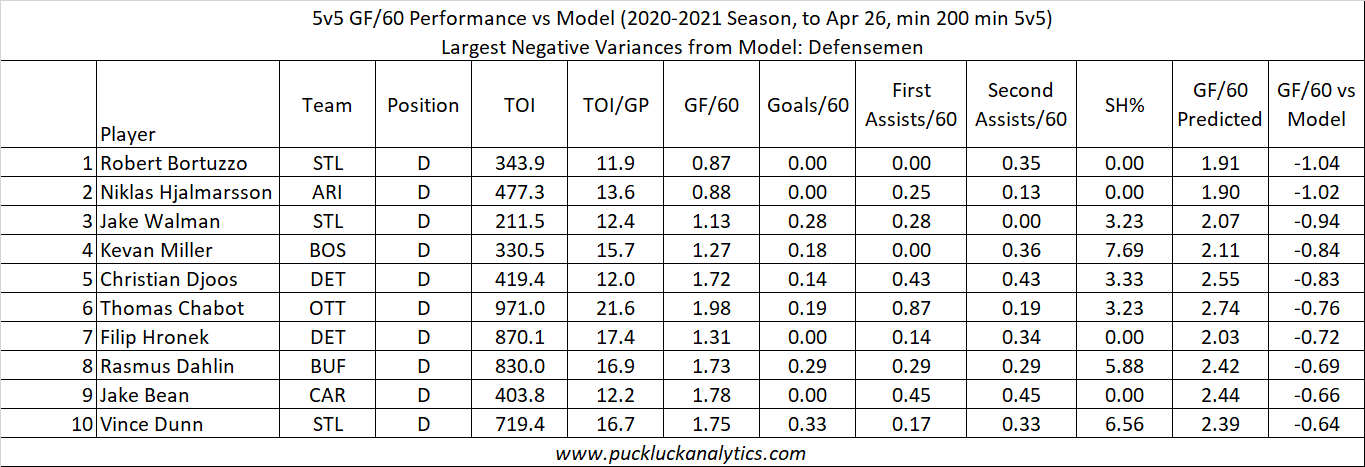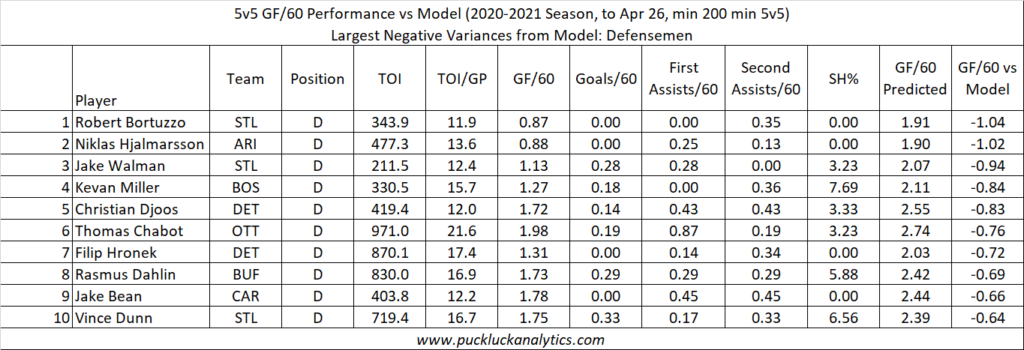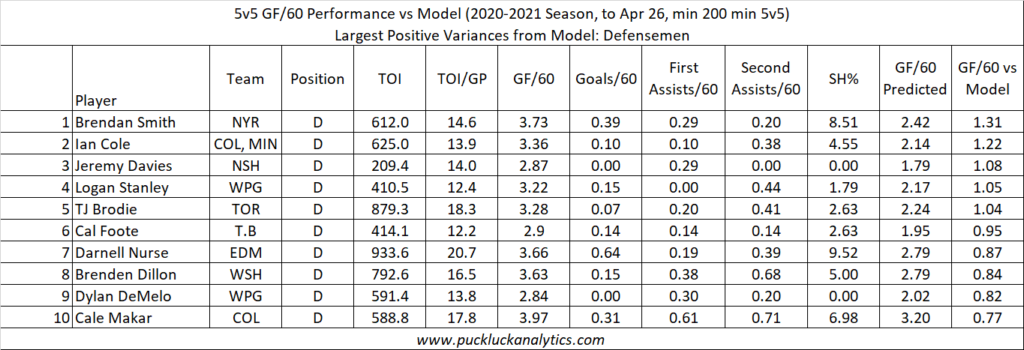In my last post, I outlined a model that predicts on-ice GF/60 for forwards based on their goal, first assist, and second assist rates. We can use this model to feed into the points predictor model using the technique for estimating team GF/60 from individual player contributions. Now, we need to add defensemen GF/60 to the mix.
Following the same approach used for the model for forwards, we are going to build a model to predict 5v5 on-ice GF/60 for defensemen using their individual stats as input. As we did with the forwards, we’ll use data from Natural Stat Trick for the past five complete seasons (2015-2016 to 2019-2020).
With our data in hand, we’ll again filter for players who played more than 200 minutes at 5v5 each season to remove outliers caused by small sample size. As with the forwards model, I tried using goal and assist rates as inputs to a couple different types of models. Once again, the best option was a multivariate regression model using goals/60, first assists/60, and second assists/60.
I expected the model to be a lesser fit than it was for forwards since defensemen accumulate points at a lower rate than forwards. This was the case, as the model returned an R-squared value of 0.37, indicating that a defensemen’s point production can explain 37% of their on-ice GF/60. For comparison, our forward model had an R-squared of 0.82. It makes sense that we have a lower R-squared for the defensemen model since we know that forwards are the primary offensive drivers.
Once again, I wanted to test whether TOI/GP would improve the model as an indicator of the quality of competition a player faces. As with the forwards, this was not productive as it had virtually no impact on the model. We’ll quality of competition as a possible future improvement to the model for now.
We saw with the forwards model that adding on-ice SH% improved the model. I added on-ice SH% to the defensemen model as well and the R-squared value rose to 0.87. This is a dramatic improvement and once again shows that the play of the other 4 skaters does a good job of explaining the GF/60 impact that our single player inputs cannot. For now, we’ll leave on-ice SH% out since we will need a good method to forecast on-ice SH% if we include it here and forecasting on-ice SH% is not easily done. Instead, we may want to go back to the GF/60 estimation technique and adjust the weighting used for forwards and defensemen impact (originally, we assumed a 50/50 weighting).
With model in hand, let’s take at a look at this season’s results compared to the model. We’ll use 200 minutes at 5v5 as a minimum, as we did when building the model. We’re looking for the same things as we did with the forwards:
- Individual SH%. Is individual shooting percentage unsustainably high or low? If yes, we can expect SH% to regress to the mean in the long term. Since goals/60 is an input to our model, movement of a player’s shooting percentage up or down will affect our model’s predicted GF/60 in the same direction.
- Players who have predicted GF/60 higher than their actual GF/60 may be carrying their line mates (ie. Others are dragging them down). This is provided that their SH% is not suspect for the difference as per #1 above.
- Players who have predicted GF/60 lower than their actual GF/60 may be carried by their line mates (ie. Others are pulling them up). This is provided that their SH% is not suspect for the difference as per #1 above.
Here are the top 10 defensemen who are underperforming relative to the model for the 2020-2021 season:
We don’t see a lot of egregious shooting percentages in the list (defensemen averaged close to 4% shooting in our 5 year sample used to build the model) so many of these players may be due for an uptick in their offensive output. Two intriguing names on the list are Thomas Chabot and Rasmus Dahlin. These young players look they are carrying line mates offensively and are poised to become big pieces on their respective rebuilding teams.
Now, let’s look at the top 10 defensemen who are overperforming relative to the model this season:
The other players here may be benefiting more from their line mates. Brendan Smith, Darnell Nurse and Cale Makar have very high shooting percentages for defensemen. We can expect their shooting percentages to regress toward league average in the long term and bring down the model’s forecast for on-ice GF/60 with it which will increase their variance from the model even further. In the case of Nurse and Makar, they have played over 50% of their 5v5 minutes with Connor McDavid and Nathan McKinnon, respectively. Likely any defenseman playing with world class forwards would see a positive effect on their on-ice GF/60. If they continue to be deployed alongside these offensive superstar forwards, we can expect that they will continue to outperform our model.
Now we that we have rudimentary models to predict GF/60 for forwards and defensemen, I’m going to turn my attention to the defensive side of the game. Subscribe to ensure you don’t miss upcoming posts looking into on-ice GA/60.






